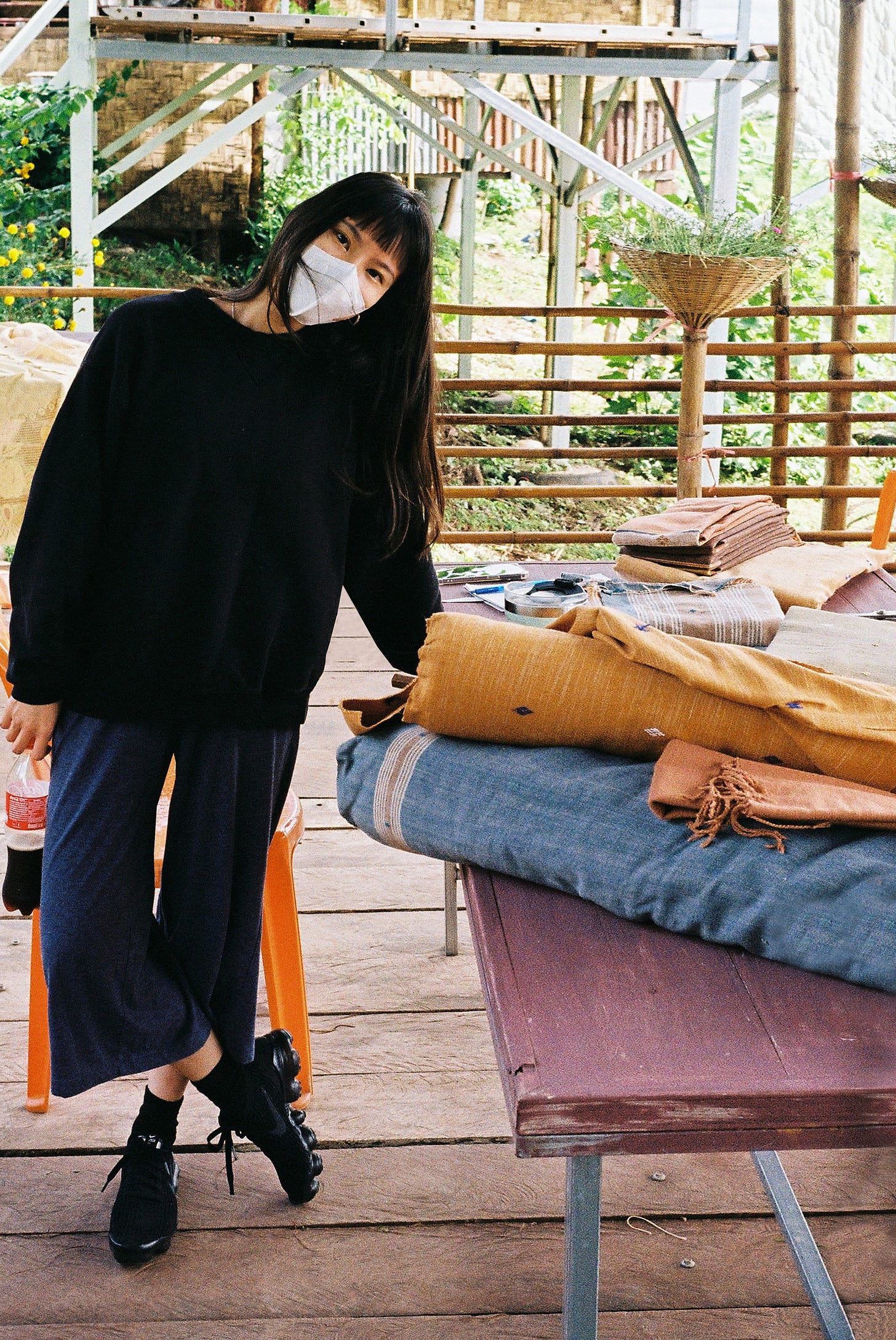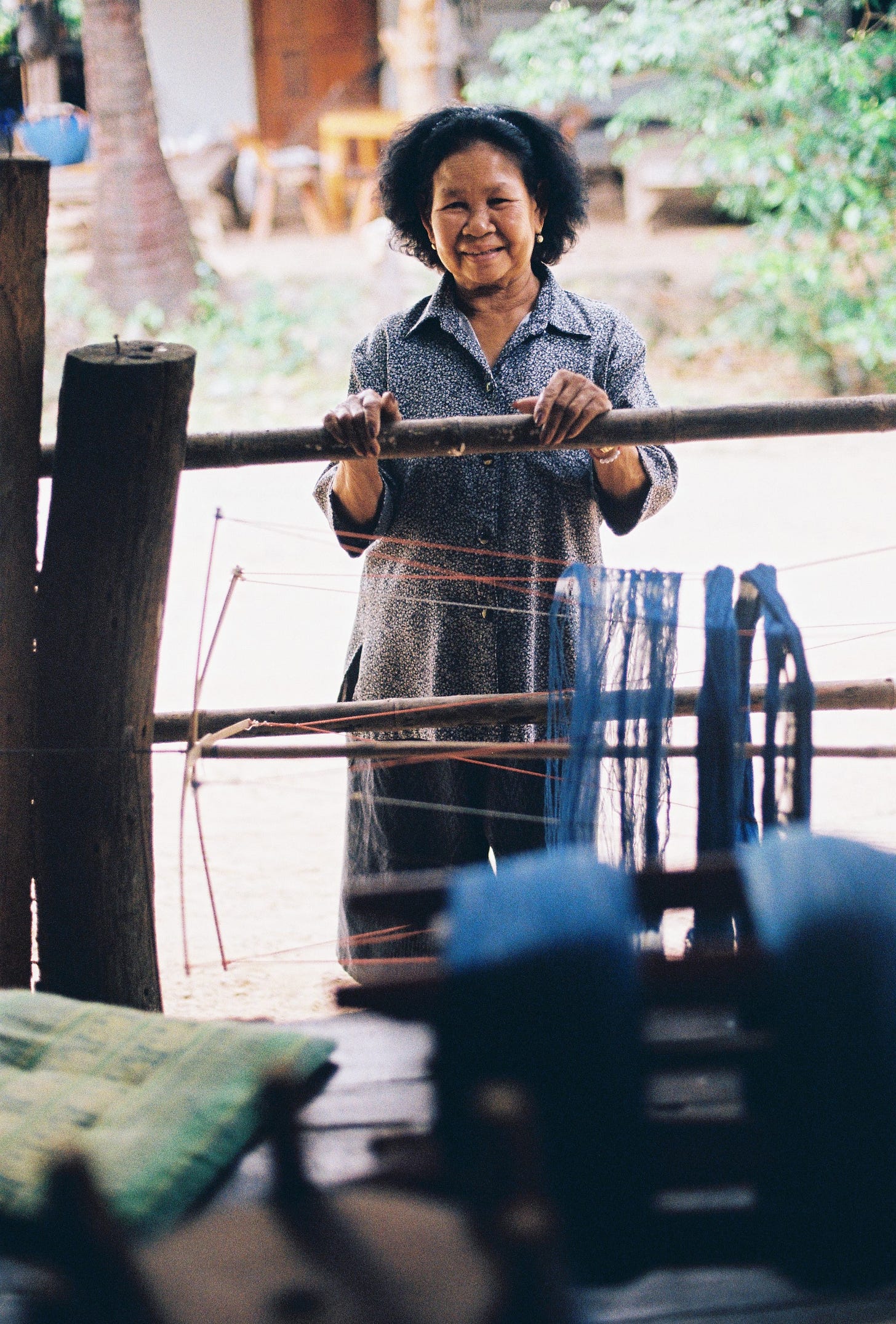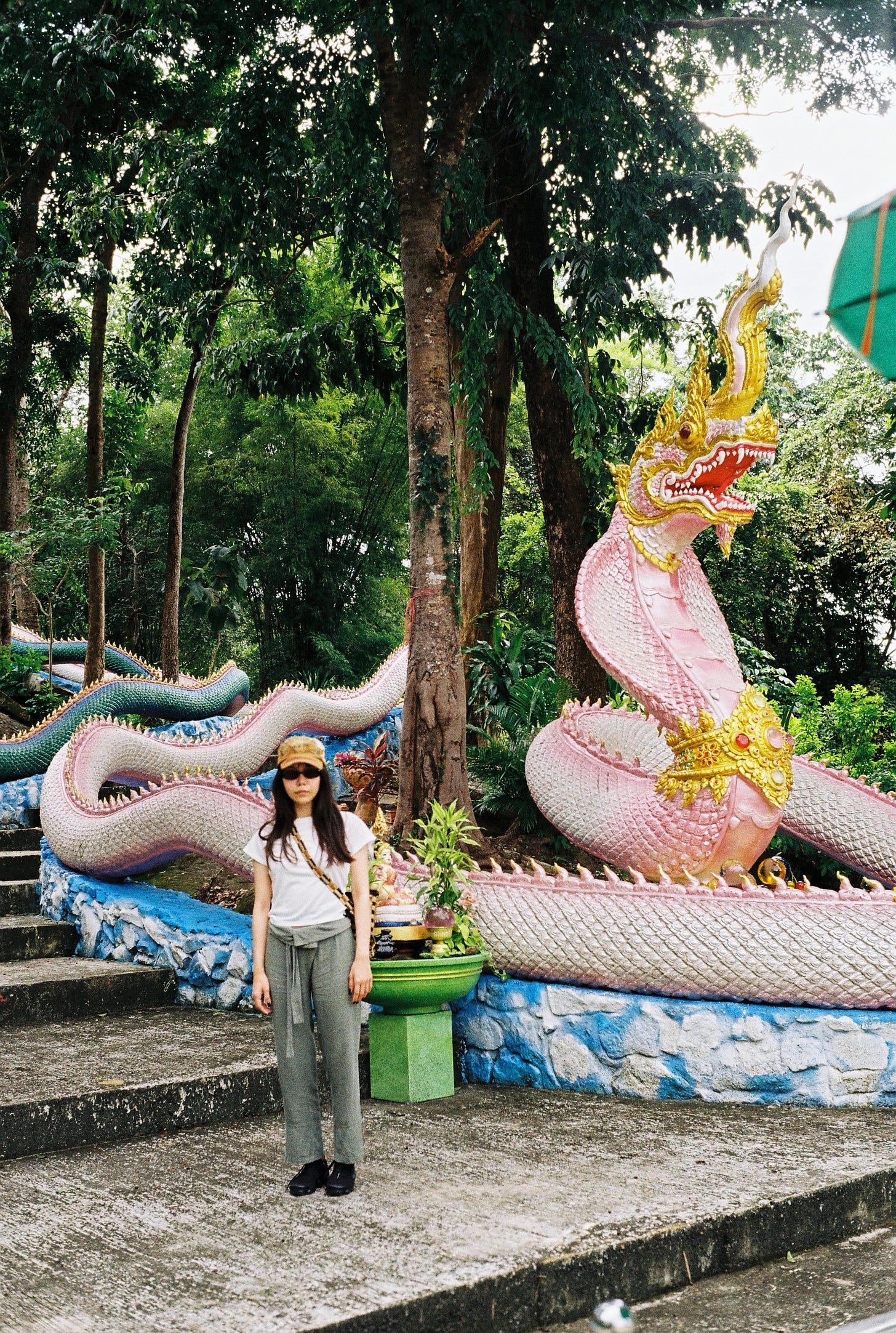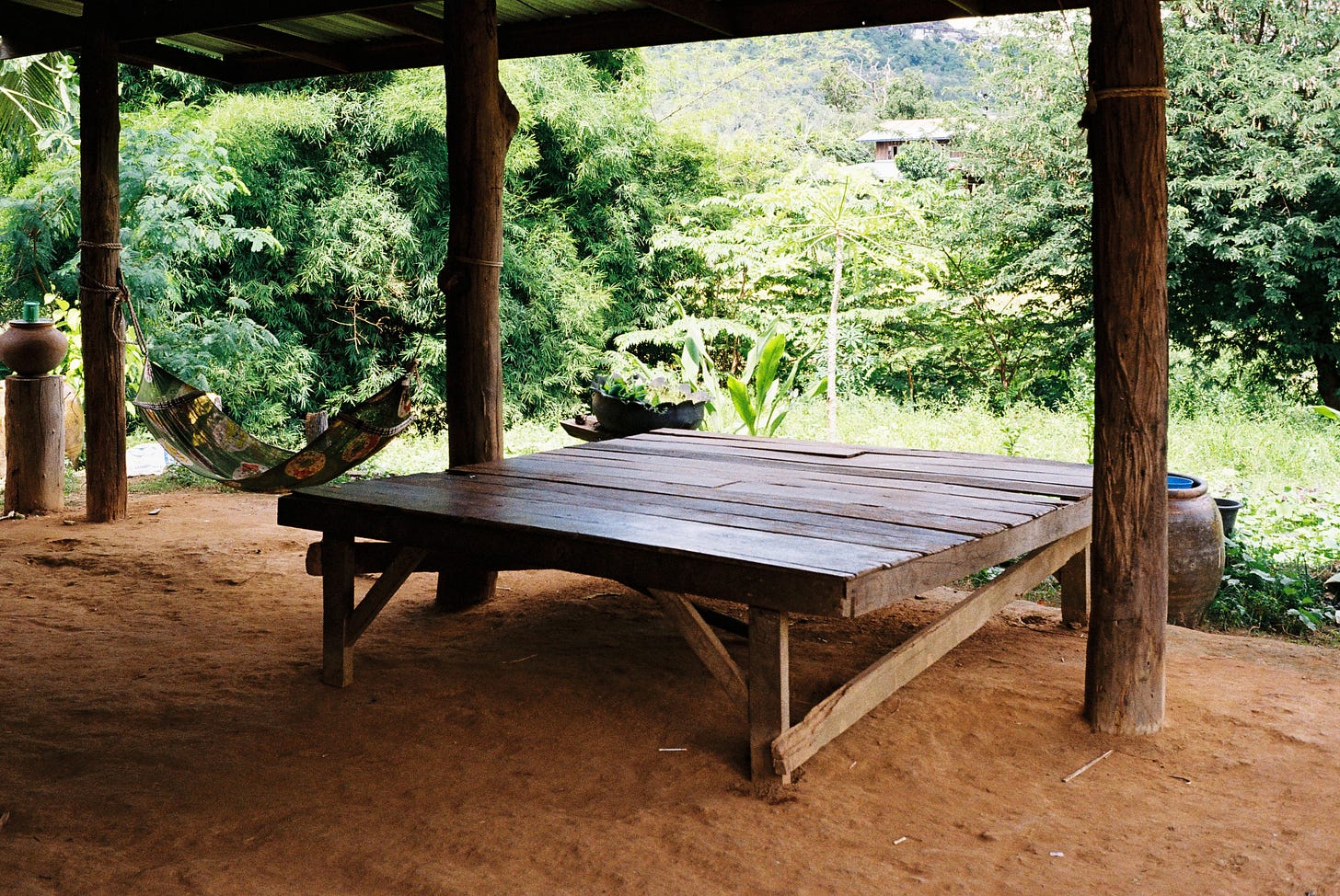#48 field notes with Designer Tammy Amorn of Seire Collective
musings from staying with artisans and designing together in their front yards
Dear reader,
I hope you’ve been finding moments of rest and warmth with your loved ones as the year winds down. Today, I’m excited to share my conversation with Tammy Amorn, the Designer and Founder of Seire Collective. Her ethos of care deeply inspires me—I hope her story resonates with you and offers something meaningful to carry with you as you set intentions for the new year (if that’s your thing). Enjoy!
When I first came across Seire Collective, I was immediately drawn to their design approach, beautifully showcased in a section of their site called Fieldworks. It felt like stepping into the quiet, thoughtful heart of the brand, where they explore the geographies, histories, and artisans behind their woven textiles. That detail left a lasting impression on me, speaking to their palpable care—for process and community, for connection.
Speaking with Tammy Amorn, Seire’s founder, only deepened my appreciation. Drawing from her experiences in Bangkok and London, as well as her background in both fashion and architecture, I could sense how she views these spheres as interconnected. For her, they form a living design ecosystem that takes into account the sociopolitical and spatial contexts of the communities she works with. In Seire’s design methodology lies the intersection of people, place, and local wisdom.
Her process defies the urgency of profit-driven fashion. Instead of fleeting collaborations, Tammy prefers cultivating long-lasting relationships. Every quarter, she travels to rural maker communities, sharing time on mats in front yards, listening to personal stories, and exploring how their histories can shape her designs. “It’s the dialogue between makers that leads you to experiment”, she says.
Seire embodies Tammy’s belief in a slower, more intentional way of creating and living. Valuing generational knowledge, her work blends heritage techniques with contemporary relevance while centring the well-being of the makers. One striking example lies in her choice of materials, guided by the weavers’ comfort—a small yet profound reminder that a collective-first approach makes all the difference.
from Bangkok to London, and back again
I moved to London when I was 18 and stayed for around seven years. I studied architecture [at Architectural Association School of Architecture], and most of my work experience later on was in design studios in London and Bangkok. From them, I learnt a lot about meeting design and production timelines. But for fashion, especially when working with local makers, it’s different.
When I started travelling to rural areas in Thailand to meet the makers, I realised they don’t work according to your time, from nine-to-five. They would work, and leave, when they feel like it. In a way, it’s about commitment not bound by legislation or contracts, but by trust.
visiting and staying with local craftspeople
I am learning what it means to gain their trust; it’s like having to make new friends. The craft itself is just an outcome of your relationship with the makers. It usually takes months—visiting them regularly, staying with them for a week or two each time—to understand how they communicate and for them to understand how I communicate, to form our language of communication.
When I was in fourth year of architecture school, I didn’t know that I’d go on to work with textile, but a weaving project introduced me to warp and weft. Visiting makers today, I learn to try different yarns and patterns, or the same patterns but with different raw materials. It’s the dialogue between makers that leads you to experiment. I find it both fun and empowering, a way to push the boundaries of craft within a contemporary context.
“can you try this out for me?”
During one of my field trips, I visited a community of embroiderers in Chiang Dao. I brought a few jackets and trousers I tailored in Bangkok with me. Every morning, I’d go to this aunty’s home, sit with them on an open mat, and they would weave.
They don’t speak Thai. I would have one person around my age—from the local community but who had a Thai standardised education—she would be our translator. They have a library of weaving patterns of flower and plant motifs. I’d ask, Can you try this out for me? From there, I’ll start to understand what’s in their library and suggest my designs.
For example, they have this pattern which translates to feet of the mouse. At first, I didn’t understand its symbolism. When I suggested reducing the pattern to three feet, they laughed, So the mouse is crippled?
Over time, I learnt their stories. I realised you don’t have to work with many makers, but with the ones you can partner with long term. I’m much more interested in working with those who are willing to experiment and ensure quality control. There’s beauty in finding people who want to develop and move forward with you.
weaving threads of space and culture
I’ve always been interested in civicness. In architecture school, my thesis was on civic tourism. My mom, who works in the food packaging industry, also shaped my thinking. Whenever I’m back home during my breaks, I’d follow her around to meet clients and farmers.
We would drive up north to visit lychee farms, to see what’s the projection for the year, for example, and how that affects plans for making orders. I didn’t realise it then, but I was learning about supply chains, and how it connects back to space.
When I came back [to Thailand] in 2020, I travelled to Isan, near Laos. A high school friend showed me how cotton is woven there. It sparked questions, like Where is the cotton from? Slowly, the dots connected: it’s by the Mekong River, with fertile land for planting cotton. In Thailand, we have a policy called OTOP (One Tambon One Product), where every district promotes one product. Growing up, I saw how industries shaped landscapes—lychee for Chiang Mai, indigo dyeing for Sakon Nakhon. I didn’t expect this to heavily influence the way I designed for Seire, but it turned out to.
craft as a living ecosystem
With Seire, I’m not greenwashing or making grand statements; I’m reflecting on conditions as I see them. I’m not against consumerism or capitalism. OTOP, for instance, improved craftsmanship because everyone focuses on one thing.
But there’s tension. Take Sakon Nakhon: When indigo dyeing became trendy, farmers stopped growing other crops. Monocropping changes landscapes—it leads to roadside farmlands and seasonal crop burning, affecting air quality. You realise this becomes part of people’s everyday living, and how it affects their lives and livelihood at scale.
So I’m interested in creating an ecosystem that works well with people and space. For one, we still use polyester mixed with cotton, because makers are more comfortable weaving this kind of textiles. This blend means that it’s not as intense for them, compared to weaving a thick yarn that requires more weight, and thus more strength they need to exert on the loom.
For our photoshoot for our fourth collection, we worked with a local photographer who has his own language of street photography. I’m not about hiring people just to get things done; I want to engage them creatively.
Craft is more than just the outcome of the makers’ livelihood; it’s a byproduct of their lived experiences and traditions. I’m invested in continuing the conversation about what craft can evolve into and how it can extend its impact. For instance, when creating infographics for our social media, I often ask myself: What can we highlight to bring more value to these craftspeople and their work?
returning to our roots
Our work is deeply rooted in the stories of the women who came before us—our moms and grandmas. For instance, we’re designing a top based on something my mom wore in the ‘70s, but crafted entirely from silk. In reinterpreting these pieces, we aim to honour our roots and traditions while keeping them relevant in a contemporary context.
This connection to the past extends beyond design and is reflected in the evolving ways our communities live. During Thailand’s industrial boom, many left rural areas to work in Bangkok, leaving children behind to be raised by grandparents. But now, there’s a noticeable shift: more women are returning to the countryside after years in the city. It may not pay as well, but it offers a healthier, more connected lifestyle. Isn't that a better option?
question of true convenience
Growing up, when I felt like eating fish, my mom would take me to the wet market. I’d pick out the fish myself, feeling the freshness, and we’d chat with the fishmonger about what was in season. It wasn’t the most efficient, but it felt meaningful. Whereas, in London, I couldn’t tell one packaged cod from another at Marks & Spencer.
I think about that a lot. What is true convenience? One measured by efficiency of time, or by intentional living?
Check out Seire Collective at their website and @seirecollective.
















